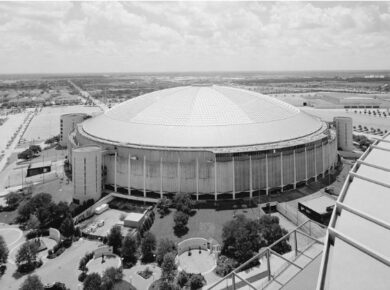
Photo: Oak Taylor-Smith
Sir Antony Mark David Gormley (born 30 August 1950) is a British sculptor. Almost all his work takes the human body as its subject, with his own body used in many works as the basis for metal castings. Gormley describes his work as “an attempt to materialize the place at the other side of appearance where we all live.” His work attempts to treat the body not as an object, but as a place and in making works that enclose the space of a particular body to identify a condition common to all human beings.

© Natalia Tsoukala / Courtesy NEON, Ephorate of Antiquities of Cyclades & the artist
Exposure (2010)

Photo: Dominicus Johannes Bergsma
As of 2010, a pensive galvanized steel giant has been looking out over the Markermeer. From afar the steel structure clearly looks like a crouching human figure, but the closer you get, the more abstract it becomes. Once you reach its feet – your head at ankle height – a tangle of steel elements towers above you. The whole looks chaotic, because all of the parts have different lengths.

Photo: Allard Bovenberg, Amsterdam
Angel of the North (1998)

Photo: Picnicin
His most famous work is the monumental Angel of the North (1998), which stands on top of a hill, gazing out over the A1, and which Gormley has referred to as ‘my Stonehenge’. Describing the ‘experiment’ that this winged steel behemoth represented to him, he says: ‘There’s no question that this is a pre-modern idea of what art can do. Here is a totem, a collectively engendered object that carries the materials and methods of the community and the place, the shipbuilding and the engineering, but uses it entirely imaginatively, in other words is non-functional, as a focus for a region’s hopes and fears.’

Source: https://www.flickr.com/photos/saw2th/5565045193/
I extracted two short passages from an interview with Alain Elkann (2020)
Is the material you use very important for your work?
Yes. Iron, and to a lesser extent steel, is concentrated earth material. Marble and bronze, for me, are too related to their historic use in sculpture. I like that iron is a common material without those associations.

Source: https://www.flickr.com/photos/conchur/130717537/
Damien Hirst and Jeff Koons call themselves artists. Instead you say: “I’m a sculptor.”
Yes, I’m a sculptor. Sculpture has a distinct and specific function. I am interested in the intrinsic qualities of mass, line, plane. I am interested in the distinctive languages of moulding, constructing, carving. I am interested in spatial displacement, in spatial articulation.

© Natalia Tsoukala / Courtesy NEON, Ephorate of Antiquities of Cyclades & the artist
About the Author:

Bruno Dursin – Managing Director at Believe in Steel. Bruno has more than 30 years of experience in promoting steel & steel solutions. His clients benefit from his extensive network within the building industry.



